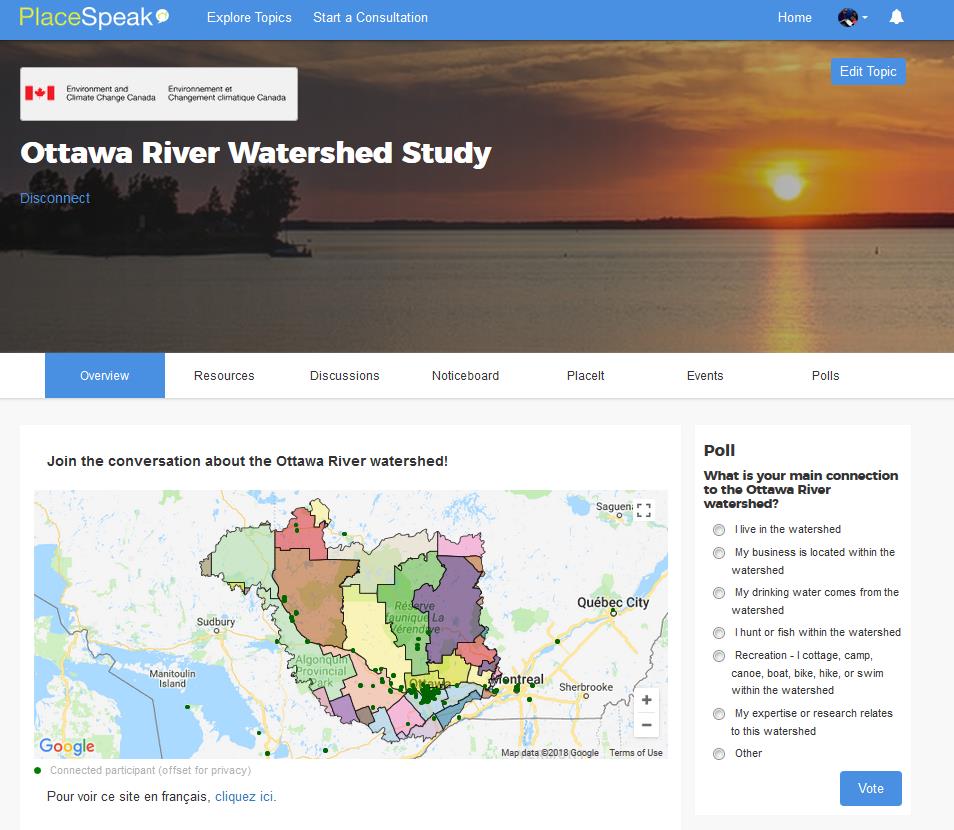WEBINAR (March 8): An opportunity to learn about innovation in public engagement in the Ottawa River watershed
Note to Reader:
As is the case in watersheds across Canada, responsibilities for, and interests regarding management of the Ottawa River watershed are shared amongst a number of players (e.g., federal government, provincial governments, Indigenous peoples, watershed organizations).
The decision to conduct a study on the Ottawa River watershed was initiated by Private Member’s Motion M-104, passed by the House of Commons on May 3, 2017. The study involves gathering information on values in the watershed, health of the watershed, and on the potential for an Ottawa River Watershed Council.
Environment and Climate Change Canada is leading the study, on behalf of the Government of Canada.
REGISTER FOR WEBINAR ON MARCH 8:
http://www.cwn-rce.ca/events/student-and-young-professionals-events/cwnsyp-webinars/ Hosted by the Canadian Water Network Student and Young Professionals Committee

Overview Page of the Placespeak online platform for the Ottawa River Watershed Study.
Visit www.placespeak.com/Ottawa-River to register and participate in the discussion.
Sharing & Learning Across Canada: “Governments in British Columbia have shown that PlaceSpeak is an effective approach to gathering public input and we benefited greatly from past experiences,” states Marina Steffensen, Environment & Climate Change Canada
Lessons learned across Canada inform Ottawa River Watershed Study
“The Ottawa River defines the border between Quebec and Ontario over a significant part of its course, and supports important recreational, industrial and ecological roles,” writes Marina Steffensen, Policy Analyst with Environment and Climate Change Canada, working with the water policy team. She is also a representative on the Canadian Water Network’s Student and Young Professionals Committee.
 “The watershed encompasses over 200 municipalities in the provinces of Ontario and Quebec, including the cities of Ottawa and Gatineau. The watershed is ecologically diverse and historically significant, and continues to play an important role in the lives of over 2 million people.
“The watershed encompasses over 200 municipalities in the provinces of Ontario and Quebec, including the cities of Ottawa and Gatineau. The watershed is ecologically diverse and historically significant, and continues to play an important role in the lives of over 2 million people.
“Environment and Climate Change Canada is gathering information on the natural, cultural, heritage and economic values associated with the watershed, and important indicators for assessing the health of the watershed.
“We are also looking across Canada, and internationally, for best practices in watershed management that could be applied to the Ottawa River watershed. Finally, the study aims to determine whether and how an Ottawa River Watershed Council should be established.”

Spectrum of Public Participation developed by the International Association of Public Participation (IAP2)
A commitment to meaningful and diverse engagement
“We designed the public engagement process based on broad and meaningful engagement. The intent is to find a way to engage citizens more dynamically – and at every point along the spectrum of public participation,” continues Marina Steffensen.
“In order to reach as many diverse groups of people as possible, Environment and Climate Change Canada has implemented a multi-pronged engagement approach, involving in-person engagement through meetings, workshops, and public events; an online engagement platform; a dedicated e-mail account, and submissions can be sent to our Department by mail.
“Collaboration with Indigenous Peoples is vital to the success of the study. A number of Indigenous groups, both within and outside of the Ottawa River watershed are implicated by the Ottawa River Watershed Study. Indigenous communities that have expressed interest in being involved in the study have indicated how they would like to be involved.
“In addition, applying a GBA+ lens to the study will help us understand how diverse groups of people experience the Ottawa River watershed, potential impacts of creating an Ottawa River Watershed Council, and how to mitigate or eliminate any differential impacts,” emphasizes Marina Steffensen.
PlaceSpeak:
“The innovative platform we chose for our online engagement is called PlaceSpeak, and we are the first federal department to use this technology,” reports Marina Steffensen. “Governments in British Columbia have shown that PlaceSpeak is an effective approach to gathering public input and we benefited greatly from past experiences.
“PlaceSpeak is designed for how Canadians behave in a digital age. Individuals are in the driver’s seat, deciding how they want to participate, on what topics, and how often they wish to be notified about opportunities to provide input. This platform will allow us to break down the feedback received, resulting in a more nuanced and meaningful understanding of how participants use and interact with the Ottawa River watershed across diverse communities.
“We are conducting informational webinars to spread the word about the study and share our experience with other water experts across the country. One such webinar is being hosted by the Canadian Water Network Student and Young Professionals Committee on March 8, 2018.”
 “We’ve chosen PlaceSpeak to host our online public engagement for the Ottawa River watershed because of a few unique features that seemed to be a good fit for the needs of our study – like the way it links digital identity to geo-location, which will let us analyze whether sentiment varies in different parts of the watershed, continues Nancy Pawelek.
“We’ve chosen PlaceSpeak to host our online public engagement for the Ottawa River watershed because of a few unique features that seemed to be a good fit for the needs of our study – like the way it links digital identity to geo-location, which will let us analyze whether sentiment varies in different parts of the watershed, continues Nancy Pawelek.
“By designing our public consultation around digital, we’ll be able to offer a variety of ways for citizens to provide their input across the public participation spectrum.
“What’s more, this platform allows participants to connect with each other and not just with us – and to stay connected after our study is over.”

Photo of the Ottawa River flooding,
CREDIT: Mario Ouellet, © Environment and Climate Change Canada

